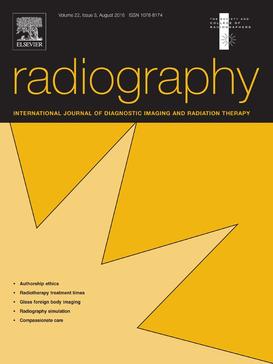Radiography (journal)
Radiography is a peer-reviewed scientific journal covering research, technology, and education in the field of radiography. It serves as a forum for radiographers, radiologic technologists, and professionals involved in medical imaging and radiation therapy. The journal aims to disseminate knowledge and promote advanced practice by publishing articles that contribute to the improvement of clinical practice, research, and education in the radiographic sciences.
Scope and Content[edit | edit source]
Radiography includes a wide range of topics relevant to the field of medical imaging and radiation therapy. This encompasses diagnostic imaging, therapeutic radiography, computed tomography (CT), magnetic resonance imaging (MRI), ultrasound, nuclear medicine, radiation therapy, patient care, and radiography education. The journal publishes original research articles, review articles, case studies, and educational materials that are of interest to the professional community.
Abstracting and Indexing[edit | edit source]
Radiography is abstracted and indexed in several major databases, ensuring that the published research is accessible to a wide audience of professionals and academics in the field of radiography and related disciplines. The visibility in these databases contributes to the impact and reach of the research published in the journal.
Submission and Peer Review Process[edit | edit source]
The journal follows a rigorous peer review process to ensure the quality and relevance of the published articles. Manuscripts submitted to Radiography undergo a double-blind peer review, where both the reviewers and the authors are anonymized to maintain impartiality and fairness in the review process. This process is critical in maintaining the scientific integrity of the journal.
Editorial Board[edit | edit source]
The editorial board of Radiography consists of a diverse group of experts in the field of medical imaging and radiation therapy. These members are responsible for guiding the journal's direction, ensuring the quality of published content, and fostering the development of research and education in radiography.
Access and Distribution[edit | edit source]
Radiography is available in both print and online formats, providing accessible options for readers and researchers worldwide. The online platform often offers additional features such as access to supplementary materials, advanced search options, and the ability to download articles for offline reading.
Impact on the Field[edit | edit source]
Radiography plays a significant role in the advancement of the radiographic sciences by providing a platform for the dissemination of research findings, technological developments, and educational innovations. It contributes to the ongoing development of best practices and evidence-based care in the field of radiography.
Search WikiMD
Ad.Tired of being Overweight? Try W8MD's physician weight loss program.
Semaglutide (Ozempic / Wegovy and Tirzepatide (Mounjaro / Zepbound) available.
Advertise on WikiMD
|
WikiMD's Wellness Encyclopedia |
| Let Food Be Thy Medicine Medicine Thy Food - Hippocrates |
Translate this page: - East Asian
中文,
日本,
한국어,
South Asian
हिन्दी,
தமிழ்,
తెలుగు,
Urdu,
ಕನ್ನಡ,
Southeast Asian
Indonesian,
Vietnamese,
Thai,
မြန်မာဘာသာ,
বাংলা
European
español,
Deutsch,
français,
Greek,
português do Brasil,
polski,
română,
русский,
Nederlands,
norsk,
svenska,
suomi,
Italian
Middle Eastern & African
عربى,
Turkish,
Persian,
Hebrew,
Afrikaans,
isiZulu,
Kiswahili,
Other
Bulgarian,
Hungarian,
Czech,
Swedish,
മലയാളം,
मराठी,
ਪੰਜਾਬੀ,
ગુજરાતી,
Portuguese,
Ukrainian
Medical Disclaimer: WikiMD is not a substitute for professional medical advice. The information on WikiMD is provided as an information resource only, may be incorrect, outdated or misleading, and is not to be used or relied on for any diagnostic or treatment purposes. Please consult your health care provider before making any healthcare decisions or for guidance about a specific medical condition. WikiMD expressly disclaims responsibility, and shall have no liability, for any damages, loss, injury, or liability whatsoever suffered as a result of your reliance on the information contained in this site. By visiting this site you agree to the foregoing terms and conditions, which may from time to time be changed or supplemented by WikiMD. If you do not agree to the foregoing terms and conditions, you should not enter or use this site. See full disclaimer.
Credits:Most images are courtesy of Wikimedia commons, and templates Wikipedia, licensed under CC BY SA or similar.
Contributors: Prab R. Tumpati, MD

